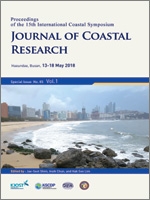Lu, C.Z.; Li, H.; Dai, W.Q.; Tao, J.F.; Xu, F.; Cybele, S.; Zhang, X.Y., and Guo, H.T., 2018. 3-D Simulation of the Suspended Sediment Transport in the Jiaojiang Estuary: Based on Validating by Remote Sensing Retrieval. In: Shim, J.-S.; Chun, I., and Lim, H.S. (eds.), Proceedings from the International Coastal Symposium (ICS) 2018 (Busan, Republic of Korea). Journal of Coastal Research, Special Issue No. 85, pp. 116–120. Coconut Creek (Florida), ISSN 0749-0208.
Suspended sediment concentration (SSC) in Jiaojiang Estuary is characterized by high concentration and significant diurnal dynamics. The large-scale reclamation will influence the sediment transport in Jiaojiang Estuary. At present, ship-borne data, remote sensing observations, and numerical modeling technique are the main technological methods to acquire the distributions of SSC. However, every method has its own limitations in application. Conventional ship-borne survey requires a lot of manpower and resources to obtain sediment distribution of an estuary although its accuracy is high. The cloudy and rainy environment has been the bottle-neck for monitoring the land and ocean surface. With the influence of land-use by human activities (such as tidal flats reclamation) being strengthened gradually, previous numerical models are not suitable for the new environment. This paper aims to combine numerical modeling technique with remote sensing observations to acquire a higher-resolution surface suspended sediment field in time and space. MIKE3 3D model was used to simulate the suspended sediments and it is composed of hydrodynamic module and mud transport module. The surface-layer sediment distribution was calculated using suspended sediment dynamic mathematical model in MIKE 3. Based on Geostationary Ocean Color Imager (GOCI) and the simultaneous surface layer sediment concentration data, a remote sensing model was developed to retrieve the distribution of SSC in the Jiaojiang Estuary. The degree of matching between the remotely sensed SSC and the numerically simulated SSC is up to 72%, both of which reveal temporal-spatial variation of the SSC. The research provides a reference for real-time monitoring and forecasting the dynamic variation of the SSC.





